Toshi Software Gallery > FabulousMP3 > Virtual Room (Binaural Simulator)
Index

Virtual Room (Binaural Simulator)
About 'Virtual Room' technology that moves the sound image outside your head
 FabulousMP3 has the 'Virtual Room' functionality that creates the virtual listening room sound space when using headphones. It simulates the arriving time and frequency characteristic difference from a sound source to each ear, and it creates a virtual surround such that sounds from outside headphones. The size or reverberation of the virtual room can be changed.
FabulousMP3 has the 'Virtual Room' functionality that creates the virtual listening room sound space when using headphones. It simulates the arriving time and frequency characteristic difference from a sound source to each ear, and it creates a virtual surround such that sounds from outside headphones. The size or reverberation of the virtual room can be changed.
The front sound localization technology
 When you listen to the music using headphone, the left and right channel sound will be separated to each ear, and you will recognize the sound location at the center of your head. It is sure that the CD music can be heard very clearly using headphone, however it is one of the factors of listener's stress because the headphone sound is deferent from usual environmental sound.
When you listen to the music using headphone, the left and right channel sound will be separated to each ear, and you will recognize the sound location at the center of your head. It is sure that the CD music can be heard very clearly using headphone, however it is one of the factors of listener's stress because the headphone sound is deferent from usual environmental sound.
If the usual environmental sound can be reproduced when using headphones, you will be able to listen to the music more comfortably.
It is said that the location of a speaker box placed in front of you can be recognized through the difference of sound arriving time and tone color between left and right ear. If the transfer characteristics from the speaker box to your eardrum can be reproduced, it is said that the virtual speaker box location can be recognized when using headphones.
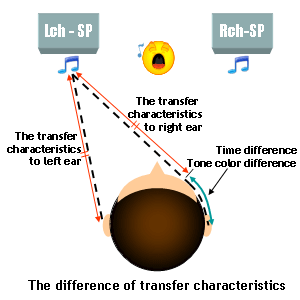
As a primitive method to reproduce the transfer characteristics, a upper body dummy model having lifelike ear structure called 'dummy head', can be used. By fitting microphones at the dummy head's eardrums and hearing the sound through them using headphones, it is said that the the sound source location can be recognized.
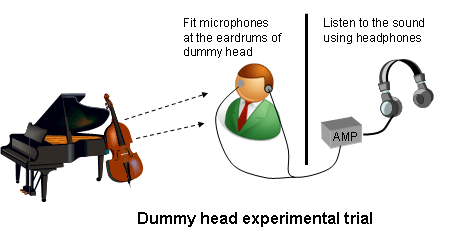
Reproduction using digital signal processing (DSP)
As a reproduction method using DSP, the convolution calculation of transfer characteristics can be used. The impulse response from a sound source to the dummy head's ear is measured and convolved it to the sound source using dedicated signal processors or general PCs. The impulse response can be measured by using a sound source which has the impulse characteristics such as a spark, or by using the M-sequence random noise and calculating cross-correlation afterward. However, the impulse response quality is depending on the measurement system. It is said that it is quite difficult to obtain the quality impulse response.
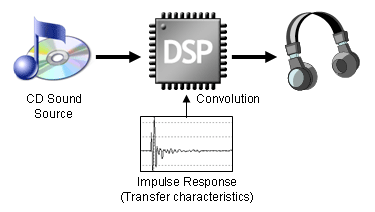
Difficulty to get the front sound localization
Even if the transfer characteristics can be reproduced perfectly, the sound from each side, which has the distinct difference between each ear, can be reproduced easily, but the sound direction from the front, rear or upside cannot be recognized clearly.
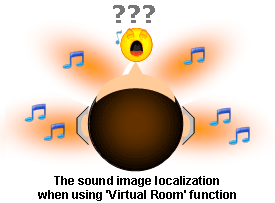
This is because that the human's sound recognition factor is not only the difference between each ear but also the visual information and the sound source movement by rotating listener's own head. Because the transfer characteristics is static when using headphones and the sound source cannot be seen, it is difficult to recognize the accurate sound source location.
One of the most advanced technologies is SONY's Virtualphones Technology. Please try it and compare it with FabulousMP3's 'Virtual Room' function. Their binaural technology is quite wonderful, but you will understand that the front sound image localization is quite difficult.
'Virtual Room' feature processing
As mentioned before, because the quality impulse response measurement is not easy and the convolution calculation requires a high computation load, the 'Virtual Room' function simulates transfer characteristics using an original 'pseudo' method including a combination of low computation load IIR filter and simple delay lines.
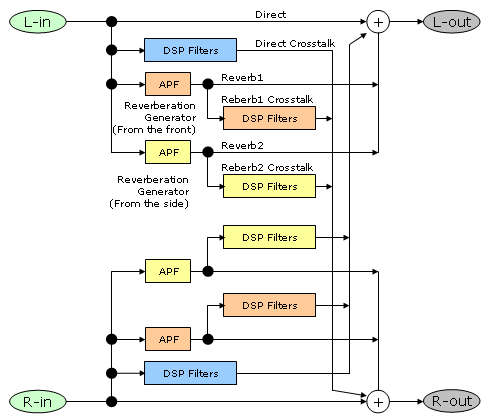
Reverberation effects
One of the factors that reproduce a distance to a sound source is the reverberation. By adding the appropriate level of reverberation, it sounds as if the sound source exists in a virtual space or room.
FabulousMP3 creates the reverberation by a combination of some general delay line feedback loops. Because the long reverberation time is not necessary, FabulousMP3 uses some all-pass-filters whose frequency characteristics is flat, but does not use any simple feedback delay line that generates unnecessary comb-filter characteristics. Two separate reverberations are created, added different direction transfer characteristics and mixed to the output. The sound image, that the reverberation surrounds around the sound source in a virtual sound space, can be reproduced.
Creating MP3 files for iPod using the 'Virtual Room' function
Actually I created some MP3 files for my iPod using the 'Virtual Room' function. Just all the same, it is difficult to recognize the front sound location clearly, but some dry-recorded song which includes less reverberation is comparatively effective. After several minutes of playback, when I get used to my headphones, I can imagine the sound source location better than before.
Effective to reduce the listener's stress using headphone
I think that this function can reduce the listener's stress when using headphone. In case of listening to the CD sound directly using headphone, the left and right channel sounds are completely separate, and it never exists in the environmental sound. When you take off your headphone, the difference between the headphone sound and the usual environmental sound will be quite large and your ears will be stressed to adjust to the usual environment.
Please try it anyway. Thank you. :-)

